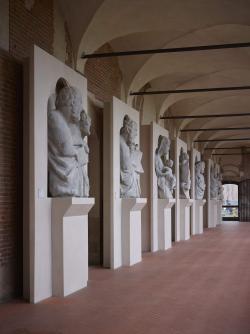Cathedral Place, Museo dell’Opera Primaziale

The Museum premises were first built to house the Canons, in the 9th century. The cloister was completed in the mid 1200s, although the cure was not. Over time, the building had several functions, until finally, after undergoing drastic alterations, it became a nunnery. Renovation in the late 20th century rediscovered the most ancient parts.
The museum collection is particularly well-provided with examples of the flourishing tradition of sculpture in Pisa between the 11th to the 14th centuries, not to mention examples of the widespread re-use of Roman carvings in the buildings on the Cathedral Place. These objects are now in the museum and can be admired, side by side with the Romanesque and Gothic worksof artists who toiled on building the monuments.
We owe the sculptures from the Baptistery and the Cathedral facade to Nicola Pisano and his workshop, in particular Giovanni Pisano; those on the buildings now are copies. Some of the statues, including the famous group from Emperor Arrigo VII’s cortège (testifying Pisa’s tumultuous political scene in the 1300s) are by the Sienese sculptor Tino di Camaino, who followed Giovanni as director of works.
The monumental wooden 13th century crucifix from France is also worth noting. It was part of a Deposition and is a rare example for Italy. Other collections in the museum are 12th to 14th century illuminated liturgical manuscripts and artifacts from the Cathedral Treasure, among which are a reliquary in ivory and Limoges enameling, holy vestments, precious drapery and a famous statue carved in ivory by Giovanni Pisano.
bigliettionline@opapisa.it
